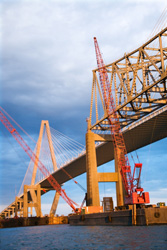New materials for renewing European bridges
The 'High performance (cost competitive, long-life and low maintenance) composite bridges for rapid infrastructure renewal' (HP Future-Bridge) project set out to develop materials and technologies for bridge renewal based on the use of fabric-reinforced polymers (FRP) as an alternative to concrete and steel. Researchers selected arched and girder bridges for further research after a preliminary review of the existing infrastructure in different countries. The arch design significantly reduces the load on the beam elements and thus their material cost; in addition, it requires a flexible deck, well suited to the use of FRP's. Team members optimised the arch design in terms of geometry, support conditions, deck systems and manufacturing. Furthermore, they developed a special resin for use in the joint systems to obtain the required strength traditionally achieved with steel and concrete. Finally, the technical characteristics of the materials were evaluated. In order to optimise technical performance and cost effectiveness of girder bridges using FRP, project partners evaluated a finite element model of the beam designed for the girder bridge. They subsequently constructed two pilot girder bridges. The reduced weight of the bridges' components permitted the placement of the beams using a simple truck-crane. The structures passed all required tests and were deemed operational. HP Future-Bridge research has led to development and extensive testing as well as evaluation of new materials and technologies for rapid bridge renewal. Experimental results supported the technical feasibility of using FRP's for such renewal. Further research should help decrease manufacturing costs of the relevant materials and facilitate commercialisation of the technology.







